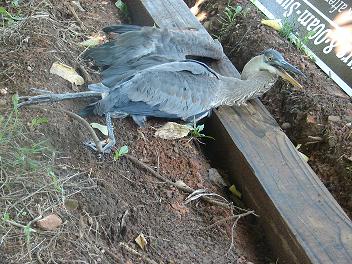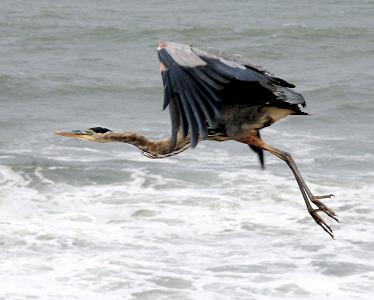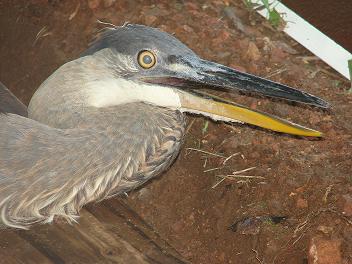The Great Blue Heron (andrea herodias)
Length: 36-54 inches; Weight: 4.8-8lbs
Wingspan: as much as 6 feet at times

The Great Blue Heron is common in North America and can be found along water habitats such as fresh and salt-water marshes, rivers, swamps, flooded meadows, lake edges, and shorelines. Their diet consists of small fish, which they spear with their long sharp beak. They are amazing creatures, able to fly at great speed from the air to the water to spear fish with powerful force.
The first time I saw one of them was beside a small creek. When it flew out in front of me up in the air screeching with its hoarse croaking squawk, I thought I had seen a long lost prehistoric pterodactyl! This bird looks tiny but is very large when in flight.
Walden’s Puddle is a wildlife refuge and rehabilitation center in Joelton,Tennessee, that takes in wildlife creatures that have been injured and helps them heal and be safely re-released into the wild. As interesting as this was to see, it was very sad to see such a magnificent creature slightly askew inside this box. However, even though it was still in the box, Elle-girl and I kept our distance. For this is a wild creature that does not understand the situation that it has been placed in.

It was at this moment the lady that had brought this bird decided that his neck looked uncomfortable inside this box and decided to scoop him up like you would a small puppy so he could re adjust. Before I could warn her that she shouldn’t move him, it was too late. As she was holding him he raised his long neck focused on her face and struck her in the eye with his sharp beak.
She was stunned and tried to assure her children that were with her that she was okay, and then her eye began to bleed.
I took her inside the office at that time, where David began to administer First Aide. After cleaning the area and providing her with an eye patch he calmly instructed her to please go straight to the ER. He later explained to me that she had a small hole puncture the size of a nail in her eyeball, and would likely have severe trauma to her sight.
In the end, Walden’s Puddle was unable to contact us in time, for it was the weekend, and the Heron, did not make it through the day.

To my readers, especially those of you living near bodies of water, please, please, please, if you come in contact with an injured wild animal, birds included, do not move it. Try to contact the proper officials. Look online for a wildlife rehabilitation center near you to contact in case of something like this. A State Park, especially a Historic State Park, is not the one to handle such a situation. Though it might seem like the right thing to do, it is not. If you cannot find someone to properly remove the animal, as hard as this might sound, you should just let nature take its course.
The woman who was injured reported back to us that her vision was fine, but the bird did in fact peck a piece of her eyeball out, thankfully it missed the pupil.
Where wildlife animals are concerned please be careful!


